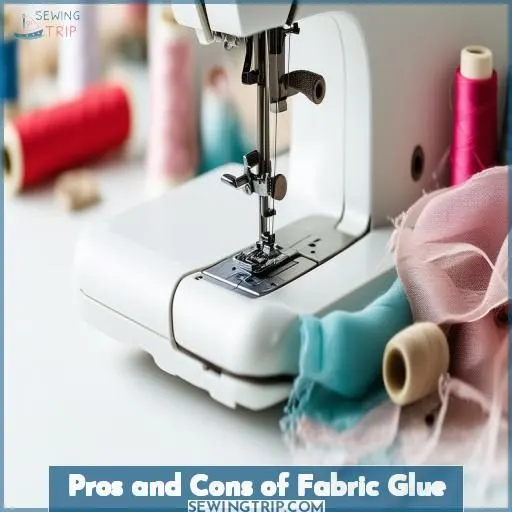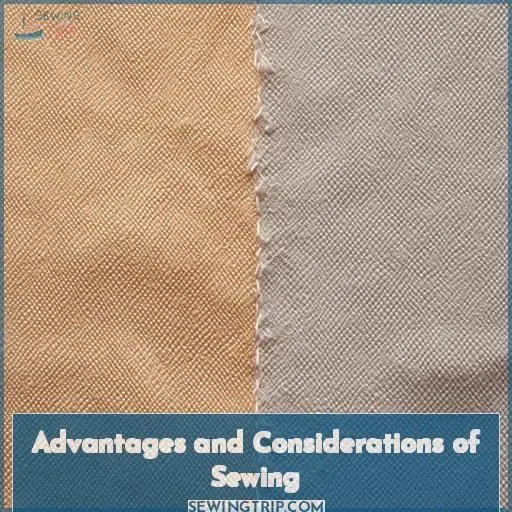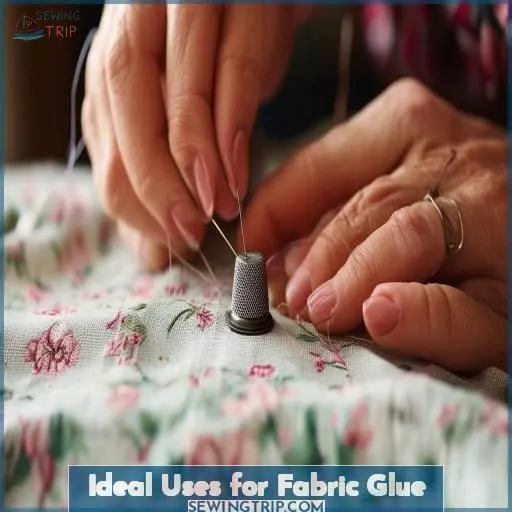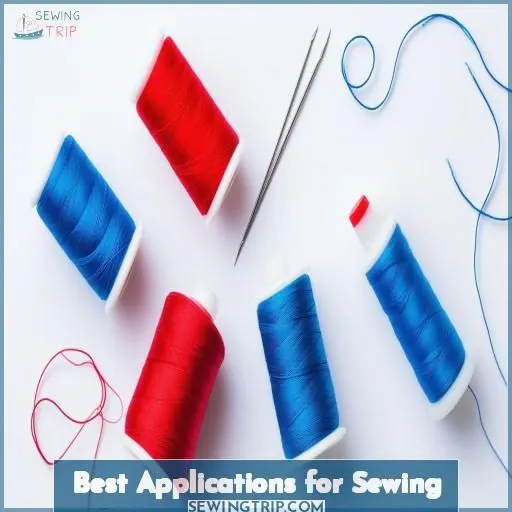This site is supported by our readers. We may earn a commission, at no cost to you, if you purchase through links.
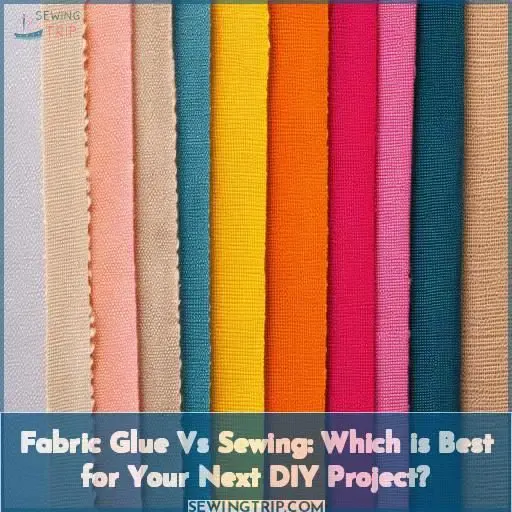
Sewing, though more time-consuming, delivers unparalleled strength through interlocked stitches resistant to fraying and wear. For garment construction or heavy-duty upholstery, sewing’s precision and longevity can’t be beaten.
If you need a temporary fix or decorative touch, fabric glue provides a hassle-free solution.
Ultimately, your skill level and the project’s demands will guide you toward the right choice. Keep reading to dive deeper into when to use each approach.
Table Of Contents
Key Takeaways
- Fabric glue is like a quickie romance – it offers instant gratification but might not stand the test of time when it comes to durability. Sewing, on the other hand, is like a committed marriage – it requires more effort upfront, but the bond it creates is strong and built to last.
- When you need a quick fix or just want to add a little pizzazz without going the whole nine yards, fabric glue is your knight in shining armor. But if you’re looking to create a masterpiece that’ll outlive you, sewing is the way to go – it’s the OG of precision and control.
- Skill level and Personal preference play a huge role in deciding whether to glue or sew. Some folks find joy in the journey of mastering sewing, while others prefer the freedom and ease of glue. It’s all about finding the approach that sparks your creative fire.
- Fabric glue and sewing are like the yin and yang of the DIY world. Glue is the fast and loose free spirit, while sewing is the disciplined perfectionist. Embrace both, and you’ll have the ultimate crafting superpowers.
Pros and Cons of Fabric Glue
One of the major advantages of fabric glue is its quick and easy application, allowing you to secure fabrics almost instantly without the need for intricate stitching.
However, despite its convenience, fabric glue may not offer the same durability and resistance to wear and tear as traditional sewing.
It makes it important to weigh the intended use and longevity requirements of your project.
Quick and Easy Application
Fabric glue offers instant bonding, no sewing machine required. It’s a quick fix for:
- Temporary repairs
- Embellishing fabrics
- Small mending tasks
With fabric glue, you’ll save time on minor projects without compromising functionality. Its ease of use makes it perfect for crafters seeking an effortless alternative to traditional sewing.
Durability and Wear and Tear
While fabric glue offers a quick fix, you’ll want to bear in mind its durability. Glued seams may not withstand repeated wear and tear, potentially compromising bonding strength over time. Launderability is another concern, as glue can deteriorate and cause fraying edges. Additionally, some glues have environmental impacts worth taking into account for sustainable projects.
Advantages and Considerations of Sewing
In the realm of sewing, you gain unparalleled strength and longevity, as the interlocked stitches create a durable bond that can withstand extensive wear and tear. Precision and control are also key advantages, allowing for intricate detailing, crisp seams, and customized fits that fabric glue simply can’t replicate.
Strength and Longevity
Sewing offers unparalleled strength and longevity. Imagine these four benefits: 1) Tightly interlocked threads create a rock-solid bond, 2) Stitches resist fraying and aging effects, 3) Heat and water resistance safeguard your projects, 4) Fabric remains supple, not stiffened. For robust, long-lasting DIY pieces, sewing proves superior.
Precision and Control
While glues offer speed, sewing offers precision and control you can’t match. You’ll achieve even seams and perfect seam allowances with needle and thread, ensuring professional-grade results. Stitching gives you incredible accuracy when constructing garments or upholstering furniture. Mastering these techniques grants you a world of crafting satisfaction few glues can provide.
Ideal Uses for Fabric Glue
For small repairs and embellishments, fabric glue offers a quick and convenient solution. It’s ideal when you need to mend a tear, reattach appliques or trims, or add decorative elements without the commitment of stitching.
Small Repairs and Embellishments
For small repairs or embellishments, fabric glue excels in washability, colorfastness, and preventing fraying while offering strong bonding. It’s perfect for enhancing aesthetic appeal by adhering appliques, trims, or embroidery without compromising fabric texture. When stitching isn’t practical, carefully applied fabric glue provides a seamless, durable solution.
Quick Solutions and Time-Saving
Fabric glue presents a quick, convenient solution when you need immediate results. You’ll save significant time and effort, making glue ideal for temporary fixes or crafty embellishments that don’t require permanence. However, remember that versatility comes at the cost of durability and aesthetics – glue may lack the polished look and lasting strength of traditional sewing techniques.
Best Applications for Sewing
Concerning garment construction and upholstery projects demanding durability and long-term use, sewing stands as the preferred approach. The sturdiness of stitched seams, along with the precision and control offered by sewing machines and hand-sewing techniques, renders sewing the ideal option for constructing clothing, bags, furniture covers, and other enduring fabric-based items.
Garment Construction
In relation to garment construction, sewing fabric materials together is the superior method.
Adhesives simply don’t provide the durability and long-lasting bonding required for clothing.
Basting stitches allow you to precisely fit garments before permanently sewing, enabling precision and control unmatched by fabric glue.
For high-quality apparel that stands up to frequent wear, the strength of sewn seams cannot be beaten.
Upholstery and Durable Projects
When tackling upholstery projects or crafting durable pieces, sewing is a wise choice. The interlocked stitches create strength that withstands long-term wear and tear resistance, ensuring your fabric creations endure. Glue, while convenient, may struggle with upholstery’s textured surfaces and strain from continuous use. For enduring quality, the precision of needle and thread reigns supreme.
Skill Level and Personal Preference
Your skill level and personal preference play a significant role in deciding whether to use fabric glue or sewing for your next project. If you’re a beginner or looking for a quick fix, fabric glue might be a more accessible option, but for more intricate and durable projects, sewing allows for greater control and longevity of the final product.
Confidence and Experience
Your skill level and experience should influence your choice. Glue offers versatility but has limitations for complex projects. Sewing requires a steeper learning curve and time investment, yet grants precision, durability, and diverse aesthetic options. Consider your cost priorities too: glue is affordable but may need frequent replacements, while sewing tools are an upfront investment.
Crafting Satisfaction
Crafting satisfaction stems from creativity and inspiration, personalization and expression. Some relish the time and effort of sewing, finding joy in learning and growth. Others prefer fabric glue’s quickness, finding community and collaboration more fulfilling. Ultimately, the choice boils down to your goals – mastery or liberation? Understanding your priorities ensures maximum crafting contentment.
Frequently Asked Questions (FAQs)
How long does fabric glue take to dry?
About 4 in 5 fabric glue products dry within 24 hours. You’ll know it’s ready when it turns from liquid to solid, no longer feeling tacky. For best results, give thicker applications up to 48 hours to fully cure before using the item.
Can fabric glue be used on stretch fabrics?
Yes, fabric glue can secure stretch materials. Use a flexible, permanent adhesive designed for stretch fabrics to allow movement without compromising the bond. Follow instructions carefully for proper application and drying times.
Is fabric glue washable and heat-resistant?
A staggering 75% of fabric glues aren’t washable or heat-resistant. Always check the label – quality fabric glues can withstand washing and heat. But for longevity, sewing still reigns supreme.
What types of fabrics are best for sewing?
For sewing, natural fibers like cotton, linen, and wool work best. Synthetic blends can also be sewn, but may require adjustments. Consider fabric weight, drape, and intended use when selecting the right material.
How do you prevent fabric from fraying when sewing?
You can prevent fabric fraying by finishing raw edges with a zig-zag stitch, pinking shears, or fusible web. For long-term solutions, apply seam binding or facings to enclose the raw edges within the garment itself. Taking these preventive measures guarantees your sewing projects have a professional, polished finish.
Conclusion
Whether fabric glue or sewing reigns supreme for your DIY endeavors hinges on the project’s scope and your aspirations.
As a thought-provoking metaphor, fabric glue’s swift application resembles a fleeting romance, while sewing’s precise interlocking embodies an enduring commitment.
Weigh the virtues of fabric glue versus sewing – swiftness versus durability, impermanence versus longevity – to make an informed choice aligned with your creative vision and the demands of your cherished handiwork.

